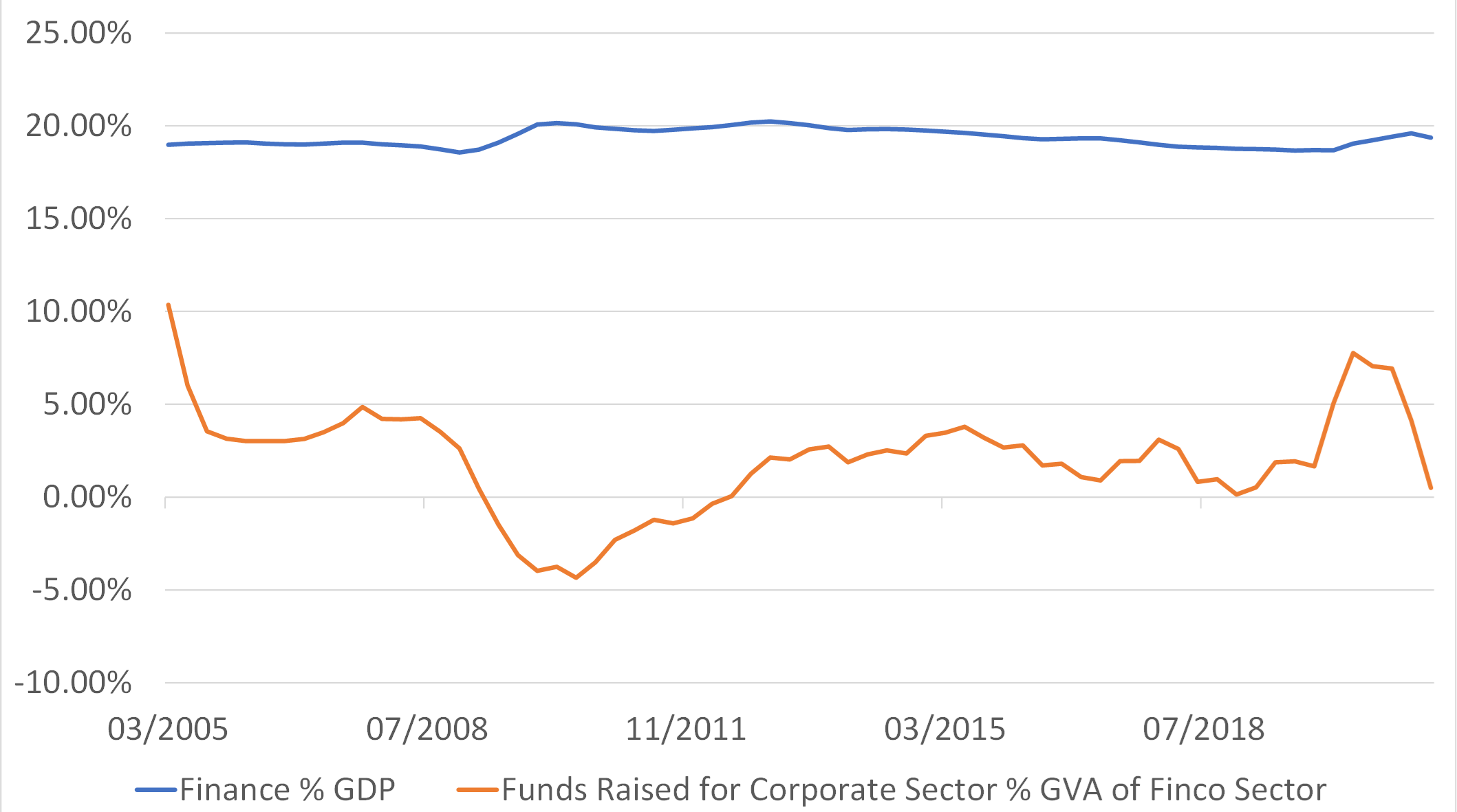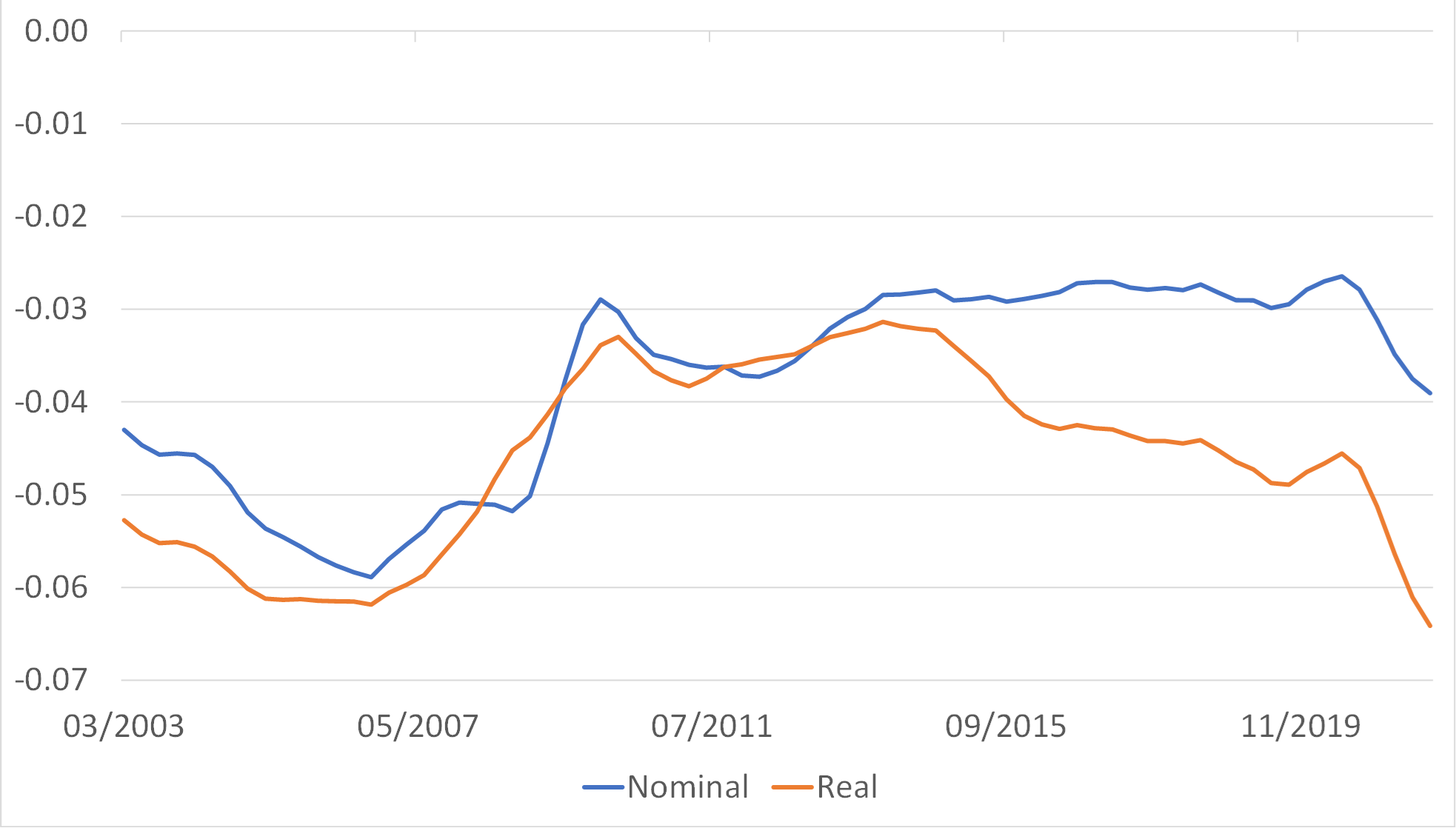Although the late 1980s’ “Lawson Boom” in the UK was an interesting first real-time introduction to a credit boom, the author’s first authentic experience of the “madness” that can accompany a credit boom was centred on Japan in 1988 and 1989. While this may now seem ancient history, it was at the time considered normal for a group of companies and banks (including the UK’s Barclays Bank) to become involved in building what became known as the “Tower of Bubble” in Otemachi. There were of course thousands of bubble buildings constructed during the period but the Tower of Bubble was perhaps unique in that not only was it was constructed on some of the most expensive real estate in Tokyo (at the peak of Tokyo’s relative valuation vis-à-vis the World, but what really set it apart was that it was three quarters air – the building’s vast central atrium extended to the roof and took up much of the building’s available volume.... When the Bubble turned to burst, most people associated with the tower – construction, financing and even tenants - found themselves paying dearly for their extravagance.... With hindsight, one can argue that they all probably deserved to do so.
From Japan, I moved on to Asia in the early 1990s. As the Federal Reserve attempted to rescue the US financial system in the wake of the S&L Crisis, the US was “spitting out vast amounts of dollars” just as the markets’ fixation with the carry trade, across presumed fixed exchange rate links, began in earnest. Based in Asia, we followed the flows of credit into the Region and in particular towards its banks. By 1993, the scale of the flows by some individual lenders – let alone the size of the flows in aggregate – into some of the ASEAN countries were simply absurd. At the time, we estimated that one US bank had positions in the MYR that were the equivalent of >10% of Malaysia’s GDP. Meanwhile, Asian banks revelled in the presumed cheap financing and used it to provide credit on an “industrial scale” to companies, properties developers, politically exposed people, and even organized crime. By 1993, not one company surveyed by the Malaysian business forums reported that they were facing credit constraints – everyone could borrow for virtually nothing!
By the end of the boom, land prices had inflated by so much that they had priced out productive investment, and virtually everyone was experiencing staff shortages as workers either stayed at home to play the markets or retired on the back of their holding gains. In Hong Kong, our own office suffered from recurring IT failures as the IT Department re-invented themselves as momentum traders in the equity markets (with management’s encouragement – it all seemed so easy to make money...), while a shortage of taxi drivers (they had become stockbrokers or property tycoons) meant that it was always hard to get home. What was the most surprising in all of this was that sensible people became sucked into the madness, somehow believing that borrowing vast amounts of money in order to produce paper wealth even as the underlying economies weakened was somehow productive and sustainable.
Naturally, the boom came to an end when the supply of dollars dried up, and the extent of the countries’ uncompetitiveness was finally revealed. However, what happened next was interesting; those that had borrowed too much were indeed expected to repay their borrowings through incredible austerity, but the lenders’ interests were protected, most notably by the IMF.
At the time, we certainly bridled against the injustice of those that had borrowed too much having to pay, but those that had lent absurd amounts of money “getting away with it” despite their (to be frank) rank stupidity in lending so much. Apparently, caveat emptor no longer applied in the credit markets. Unfortunately, this scenario was to be repeated on many occasions, including in Iceland and Greece, in the decades that followed. Burden sharing for mutual mistakes (it takes two to borrow too much..) would have been fairer and might also have introduced some notion of credit risk and prudence back into banking....
From a theoretical perspective, we would advocate the rediscovery of credit risk and a resetting of lending practices so that both borrowers and lenders suffer risks and losses – and we presume that one day we shall go back to this world. However, as we have busied ourselves reading the writings and often self-promoting interviews of several recently retired ex central bankers, we have noted that the new model is that neither borrower nor lender should be allowed to suffer losses.
In a recent interview in the Asian Banker, Mark Carney went so far as to suggest that, under his new system of “values”, the Asian Crisis should never have been allowed to happen. By this he was not implying that the credit boom that preceded it should have been stopped sooner, but rather that the central banks and supernational organizations such as the IMF should have ensured that no one had to suffer the consequences of their previous actions. From this we infer that he and many of his former colleagues in central banking land believe that a soft bailout should have been arranged, rather like that which was used only a little while later to deal with the LTCM Crisis.
Indeed, as we look back, it does seem that the LTCM Crisis marked something of a watershed in policymaking. For those that were not in markets at the time, the brains trust of Nobel Laureates and traders at LTCM had created an extremely leveraged vehicle in order to speculate in a number of actually quite naïve and correlated trades that relied on some really quite wonky assumptions. When the latter proved (fundamentally) wrong, the fund imploded and in so doing threatened to unleash a wave of counterparty failures through the financial system. Faced with a building crisis, the Federal Reserve called all of the fund’s creditors together into one room in order to work out a “deal” and it also eased policy so that the positions could be unwound. The collusion proved successful and arguably no one suffered long term losses – even many of the people involved went on to “other things” - but the easing of policy undoubtedly provided the credit fuel for the NASDAQ Bubble and all of the madness that accompanied that particular cycle....
Today, the public sector bailout mantra is seemingly everywhere pervasive, despite the immense moral hazard issues that it breeds. For example, if you are a large hedge fund that has been caught the wrong side of a move in Treasury bond prices during a Pandemic, then the Fed will it seems buy the offending bonds from you to both bail you out and keep borrowing costs for the government down. This is far more extreme and certainly more “micro” than the Greenspan Put ever was even in its heyday.
It is therefore of no surprise that market participants have looked at the central banks’ actions and concluded that there is in fact no risk when it comes to acquiring risk. It apparently takes extreme Erdogan-like behaviour to actually initiate a currency crisis or even a fall in prices. No wonder the valuation of risk is now so low....
The Asian Boom ended with what we might term implicit inflation. High property and asset prices not only inflated the cost of doing “real things” (like building consumer electronics in Malaysia or cars and food products in Thailand), but also diverted resources into the unproductive transferring of pieces of paper and second-hand property between speculators. Notionally, GDP was created from the sales commissions, but as people gave up their day jobs to speculate, the underlying economies became less and less efficient and unit labour costs rose behind the smokescreen of soaring financial markets and booming property markets. Of course, once the smoke screen of easy money dispersed, the economies were found to “have no clothes”.
No one knows by just how much the pool of labour available to US companies has been reduced by people staying at home in order to play the markets, but there are many people who suspect that the numbers are not insignificant currently. We do know just how big the finance sector has become not just relative to GDP but also in relation to just how much money it provides to the real economy. We also know that if we remove the Finance Sector and just a few other sectors from the GDP data, then the bulk of the US economy today is still smaller than it was before the Pandemic.
USA: Gross Value Added of finance Sector

In a recent US review, we highted the large gap that has emerged between the income that the US is presumed to be generating, and the amount of output that is being created. We also know that domestic expenditure is exceeding domestic output by a considerable margin. The US is clearly consuming more than it is producing and “covering” the difference with credit and imports. Parallels between Asia in the mid-1990s abound, and we are certainly witnessing the same implicit inflation and degradation of supply relative to demand. The weakening current account position is merely a symptom of this, as indeed it was in the Asian countries a generation ago.
USA: Current Account Balance
% GDP

In late 1989, the BoJ finally raised rates and in 1990/91 it pretty much forbade Japan’s banks from lending money. The boom ended. During 1997, foreign creditors fled Asia and the Crisis unfolded. If and when the credit tide recedes, systems will no doubt tend to crash along with market prices but the Federal Reserve has already shown that it is in no mood to let the system crash – its revealed actions over recent weeks make this clear and we suspect that it will take “high levels of persistent inflation” to sway it from its course. Quite simply, we have been amazed by how accommodative the Federal Reserve has been over recent days. The question for investors then is will inflation in 2022 be high enough to force a reluctant Fed to tighten despite the obvious risks that this would imply for the world that it has created - and the historical precedents that we have highlighted?
We suspect that in reality the Federal Reserve is hoping that a combination of economic weakness in China, the fiscal tightening in the USA, and some improvement in the situation within the supply side will allow it to escape having to press the tightening “doomsday” button.
For our part, we suspect that the Fed will indeed be lucky and that China / Fiscal policy will allow it to delay the inevitable, but to miss-quote the Duke of Wellington at Waterloo, “it’s going to be a damn close thing”.
If China and a US fiscal tightening (together with the existing economic weakness in Europe) are not sufficient to cause a dis-inflationary global slowdown, then one day the Fed will have to follow the BoJ down a potentially deflationary tightening route, or risk inflation taking a profound hold of the system. (It should be remembered that Japan started the 1990s with an inflation problem, the policy response to which triggered deflation). To use another over-used quote, we are living in interesting times of monetary instability.



